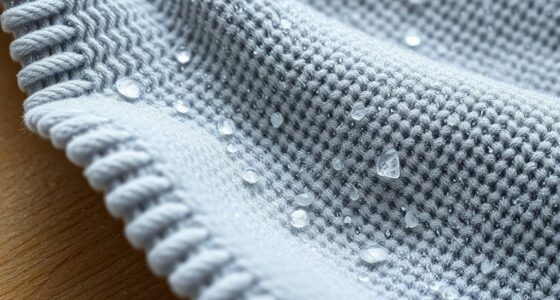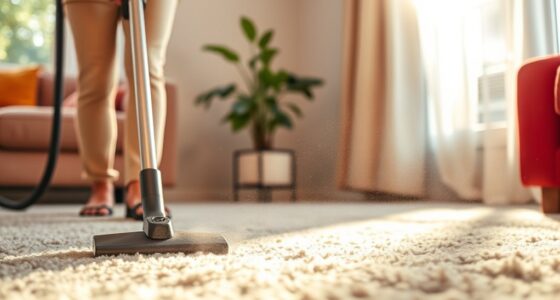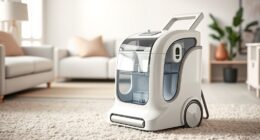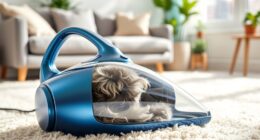To prevent dust resettlement, start by dusting high surfaces like ceiling fans, light fixtures, and shelves using microfiber cloths or vacuum attachments. Clean from top to bottom to catch dust before it falls onto lower furniture and floors. Regularly use air purifiers with HEPA filters to trap airborne particles and maintain ideal humidity levels around 40-50% to discourage dust mites. Continuing this routine helps keep your space consistently dust-free and fresher longer.
Key Takeaways
- Start cleaning with high surfaces like ceiling fans and shelves to prevent dust from falling onto lower areas.
- Use microfiber cloths or vacuum attachments for effective dust removal from elevated surfaces.
- Employ air purifiers with HEPA filters to capture airborne dust before it resettles.
- Maintain proper humidity (40-50%) to reduce dust mite activity and dust accumulation.
- Regularly vacuum floors and soft furnishings to remove settled dust and minimize resettlement.

Have you ever noticed how dust seems to settle back into your space just after cleaning? It’s frustrating to put in the effort only to see dust reappear moments later. The key to preventing this cycle lies in understanding how dust resettles and how to break it. One effective way is by using air purifier benefits to your advantage. An air purifier helps filter out airborne dust particles, reducing the amount that settles on surfaces. When dust particles are captured before they settle, you’ll notice less accumulation on furniture and floors, and your cleaning efforts will last longer. Plus, many air purifiers also help control dust mite populations, which are a common cause of indoor allergies and respiratory issues. Dust mites thrive in dusty environments, feeding on dead skin cells and creating allergenic waste. By reducing airborne dust and controlling these tiny pests, you protect your health and minimize dust buildup.
To maximize dust mite control and make your cleaning more effective, it’s important to adopt a top-to-bottom cleaning approach. Start with high surfaces like ceiling fans, light fixtures, and shelves. Dust these areas thoroughly, using a microfiber cloth or a vacuum attachment designed for dust removal. Dust tends to settle downward, so cleaning high areas first prevents it from falling onto already cleaned surfaces. Next, move to mid-level furniture, such as tables, desks, and countertops. Use a damp cloth or microfiber duster to trap dust rather than dispersing it into the air. Once the higher surfaces are dust-free, focus on floors and carpets. Vacuum thoroughly, especially in corners and along baseboards, to pick up any remaining dust and debris. Regular vacuuming with a HEPA filter is essential, as it traps tiny particles that would otherwise resettle. Incorporating air filtration technology can further enhance your cleaning routine by continuously removing airborne particles.
In addition to vacuuming and using an air purifier, consider incorporating humidifiers into your space. Maintaining proper humidity levels (around 40-50%) discourages dust mites from thriving. When dust mites have less moisture to survive, they become less numerous, reducing dust buildup over time. Also, change your bedding, curtains, and soft furnishings regularly since these are hotspots for dust and mites. Using allergen-proof covers on pillows and mattresses adds an extra layer of protection. Remember, consistency is vital—routine cleaning and air filtration work hand-in-hand to keep dust from resettling. This way, your home stays cleaner longer, and your breathing feels clearer. By staying diligent with these strategies, you’ll find that dust no longer has the upper hand, and your space remains fresh and healthier for longer periods.
Frequently Asked Questions
How Often Should I Clean High Surfaces to Prevent Dust Buildup?
You should clean high surfaces at least once a week to prevent dust accumulation. Regular cleaning reduces the amount of dust that can resettle on lower areas, keeping your space cleaner and healthier. If you have pets or allergies, consider increasing the cleaning frequency to twice a week. Consistent dusting and wiping down high surfaces help break the cycle of dust buildup and keep your home fresher longer.
Are There Specific Cleaning Tools Recommended for High Areas?
You’ll want the right tools to conquer high dust—ironically, the tiniest duster types and cleaning attachments work best. Opt for feather dusters, microfiber dusters, or extendable tools with angled heads. These help reach the tricky spots without climbing on chairs. Using the right duster types guarantees dust doesn’t resettle, making your cleaning more effective and less of a never-ending saga. So, get those attachments ready and dust away!
Can Air Purifiers Reduce Dust Resettlement Effectively?
Air purifiers can effectively reduce dust resettlement when you maintain them properly. Make certain to regularly change or clean dust trapping filters, as clogged filters lose efficiency. Proper air purifier maintenance ensures that dust is captured before it settles on surfaces. Using an air purifier in high-traffic or dusty areas can considerably improve indoor air quality, helping to keep dust from resettling and maintaining a cleaner environment overall.
What Cleaning Products Are Best for Long-Term Dust Prevention?
Imagine battling a never-ending dust monster—you need eco-friendly solutions that truly fight the battle. Microfiber cloths are your secret weapon, grabbing dust like a magnet and preventing resettlement. Use eco-friendly cleaning products that are gentle on the environment but tough on dust. Regularly wiping surfaces with microfiber and choosing sustainable cleaners keeps dust at bay longer, so your home stays cleaner, healthier, and less like a dusty battleground.
How Does Humidity Affect Dust Resettlement and Cleaning Efficiency?
Humidity control plays a vital role in dust resettlement and cleaning efficiency. When you maintain humidity levels between 40-50%, you slow down dust mite growth and reduce airborne dust particles. Proper humidity prevents dust from settling quickly on surfaces, making cleaning more effective. If humidity is too high, dust resettles faster, and mold can develop, while too low humidity can cause dry dust to become airborne, complicating cleanup efforts.
Conclusion
Just like a steady hand guides a painter’s brush, your mindful cleaning prevents dust from settling again. Remember, every sweep and wipe breaks the cycle, keeping your space fresh and clear. Don’t let dust reclaim its throne; stay vigilant like the watchful eye of time itself. By staying consistent, you create a sanctuary where cleanliness reigns, and dust’s reign ends—bringing peace of mind and a healthier home, echoing the timeless dance of order and renewal.









